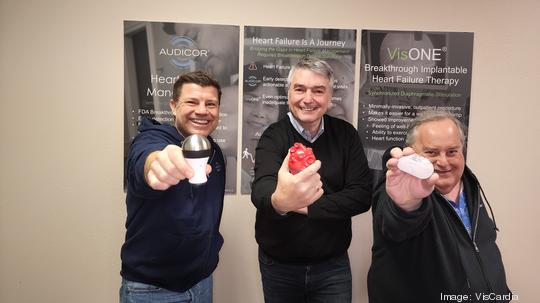
About 10 million patients in the U.S. and Europe suffer from heart failure, a progressive disease that can usually be managed by drugs such as beta blockers.
Eventually, the drugs cease to work effectively, but the patient may not be ready for a heart pump or transplant.
A privately held Beaverton company has come up with a way to fill that gap and strengthen a weakened heart. VisCardia, which spun out from Inovise Medical Inc. in 2015, developed a device that can be implanted in the diaphragm in a simple outpatient procedure. The VisONE basically recruits the diaphragm “as a type of circulatory assist mechanism,” according to VisCardia.
The company has raised about $20 million to date. A recent $1.5 million investment is “just one little stepping stone” in a $25 million round that’s underway, said President and CEO Peter Bauer.
“We’re ready to execute, and it’s going to be very exciting,” Bauer said.
'Unclog the drain'
Inovise and spinoff VisCardia share a headquarters space and 10 employees. Inovise’s origins go back to the former HP Medical in McMinnville. The executive team, including entrepreneur Patti White, founded Inovise in 1997 to focus on cardiac diagnostics. The company has developed a novel, non-invasive remote monitoring system for heart failure patient management.
Whereas Inovise’s technology helps to optimize a patient’s drug regimen, the VisCardia implant comes into play when those drugs lose their effectiveness.
“What VisCardia is doing is using the diaphragm to modulate the pressure within the chest, so when a weak heart pumps, it can pump more blood,” said Gregg Harris, VP of clinical and regulatory matters at VisCardia. “It allows the weak heart to deliver oxygen more effectively and efficiently, without using more energy. It can unclog the drain.”
The VisONE Sytem, which consists of a pulse generator and two leads, is connected to the diaphragm during a laparoscopic procedure and doesn’t touch the heart. Although it stimulates the diaphragm, but the patient doesn’t feel it, Bauer said.
“It’s a smaller movement (than a hiccup) but it’s significant enough to change the pressures in the thorax to make it easier for the heart to pump,” he said.
The 45-minute outpatient procedure involves a one-centimeter incision in the abdomen to insert the stimulator.
“It’s labeled as minimally invasive,” Harris said. “It’s an easy procedure.”
Breakthrough designation
In 2018 and 2019, VisCardia did a European clinical study involving 19 patients that established that they had better exercise tolerance, quality-of-life scores and cardiac performance, Harris said.
“We’ve even shown that the heart tends, over a year of therapy, to start healing and becomes stronger on its own,” he said. “It’s like giving it a crutch and letting it work better.”
VisCardia submitted the data to the Food and Drug Administration, which granted it a breakthrough device designation that will facilitate bringing the product to market in the U.S.
The company plans to use its upcoming funding round to see it through the clinical trial and hire 10 to 20 more people. VisCardia’s lead investor has been a Canadian family office out of Vancouver, Bauer said.
VisCardia is targeting 20 U.S. medical centers that could participate in the study. It will likely take a year to 18 months for enrollment, and then a year’s worth of data is needed, meaning it will be three to four years before the device can go to market.
“That’s a pivotal study for demonstrating the safety and efficacy of the device,” Bauer said.
Study participants will be patients aged 65 and older who are at the late stages of heart failure.
“Those are patients that are typically managed pharmacologically,” Harris said. “Unfortunately, the disease is progressive and gets to a point where drugs keep them alive, but they have a poor quality of life. They’re not sick enough to get a transplant or artificial heart pump, but they’re too sick for the drugs to keep them healthy.”
Bauer compares the situation to a car with a failing engine that can’t climb hills.
“We’re tilting the slope,” he said, “so it’s less of an issue for an old car to get up a hill.”
VISCARDIA
Headquarters: Beaverton
Founded: 2015
President and CEO: Peter Bauer
Employees: 10
Raised to date: $20 million



